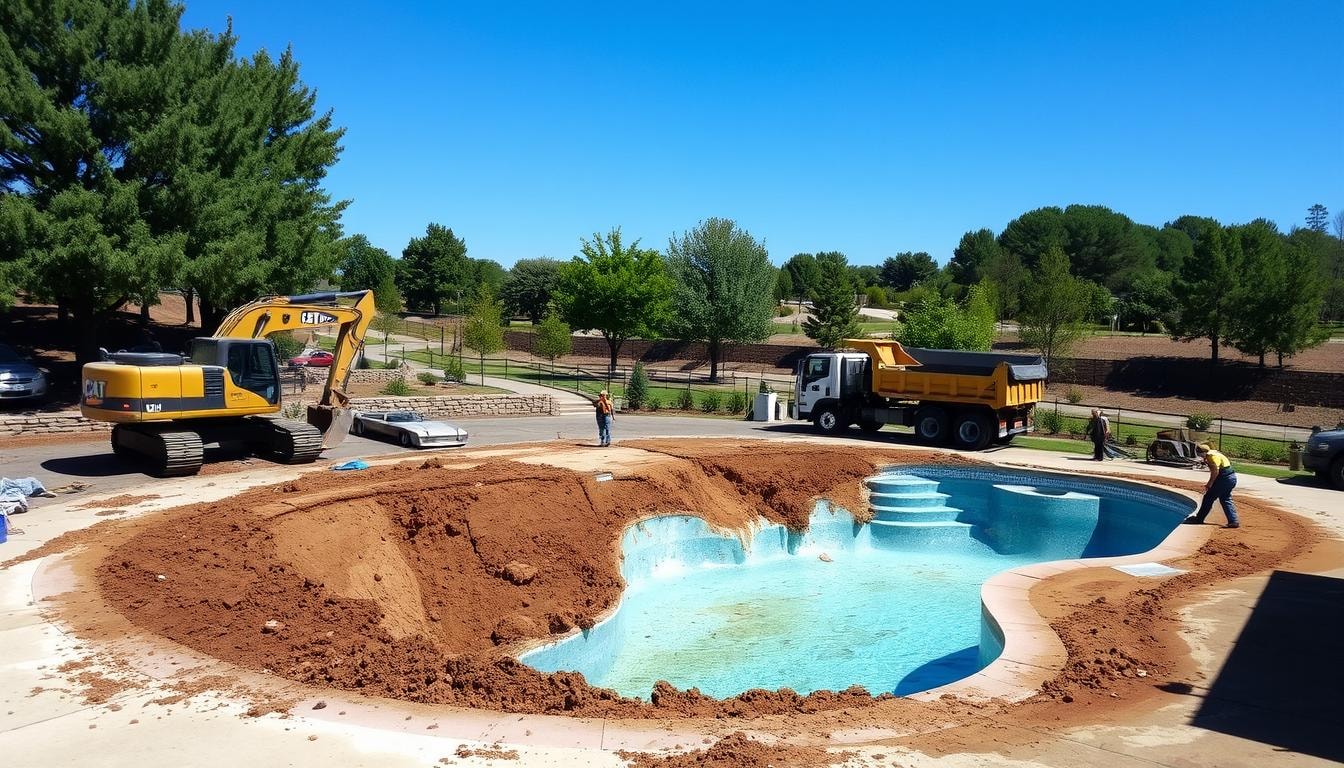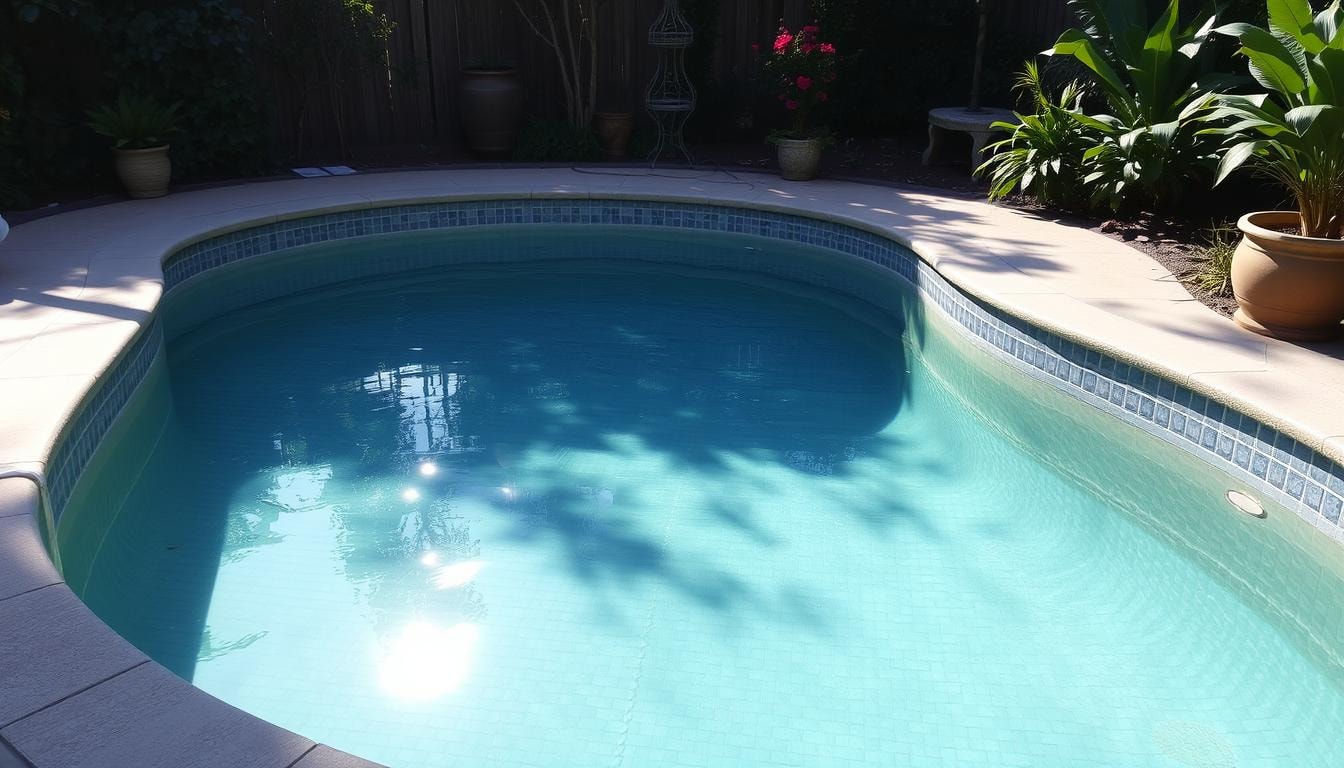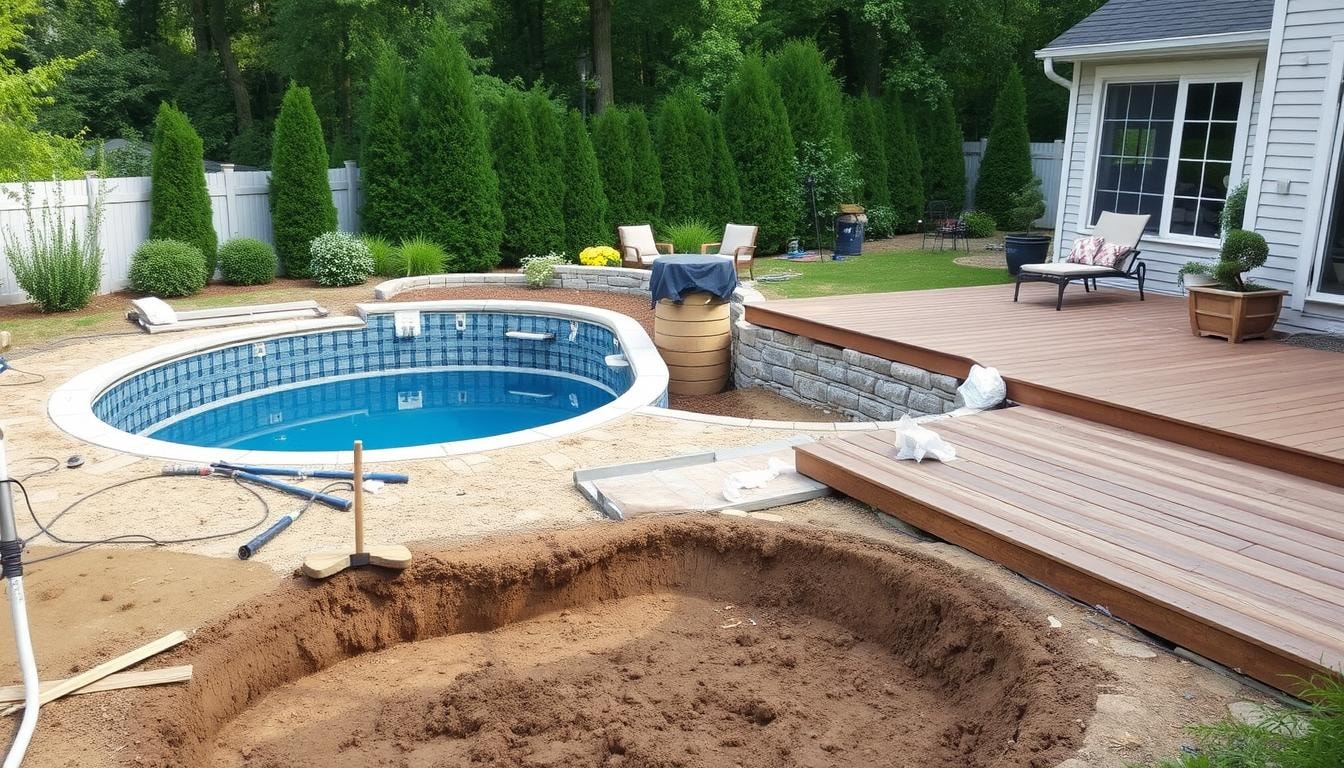Pool Removal Near You
Can’t find what you are looking for?
How It Works
-
Answer a few questions about your home project.
-
Within seconds, get matched with top-rated local pros.
-
Compare quotes and choose the best pro for the job.
Pool Removal In Your Area
The Pool Removal Process: Step-by-Step
Meta Description: Discover the step-by-step process of Pool Removal, from planning to completion. Learn about costs, permits, and methods to transform your backyard effectively.

Is your old pool causing maintenance headaches and safety worries? Pool removal can transform your backyard into a more functional space. This guide will help you navigate the process with confidence.
We’ll cover everything from reasons for removal to getting permits and executing the demolition. This information applies to both above-ground and in-ground pools.
Key Takeaways
- Gain insights into the common reasons for pool removal, such as high maintenance costs, safety concerns, and lack of usage.
- Explore the different methods of pool removal, including partial and complete removal, and understand the associated costs and timelines.
- Learn about the importance of obtaining the necessary permits from local authorities before initiating a pool removal project.
- Discover the step-by-step process of draining the pool, breaking up the structure, backfilling the area, and final grading and seeding.
- Understand the options for repurposing the pool area, such as converting it into a patio, garden, or deck, and the potential increase in property value.
Reasons for Pool Removal
Owning a pool can be costly. Cleaning, treatments, and repairs add up quickly. Safety worries, like drowning risks, trouble many homeowners. Some pools go unused, leading to removal decisions.
High Maintenance Costs
Pools need lots of time and money. Chemicals, electricity, and cleaning all cost money. These costs can be too much for infrequent pool users.
Safety Concerns
Pools can be dangerous, especially for kids and older folks. Drowning risks worry many homeowners. Some choose safety over pool convenience.
Lack of Usage
Unused pools become eyesores. This can hurt home value and appeal to buyers. Some owners decide to remove pools and use the space differently.
Consider these factors when deciding about pool removal. The process can be tricky. A pro pool removal contractor can help make it smooth.
Types of Pool Removal
Homeowners have two main options for pool removal: partial or complete. Each has its own benefits and considerations. Understanding the differences is crucial for making the best decision.
Partial Pool Removal (Filling In)
Partial pool removal keeps the existing structure and fills it with approved materials. This method is faster and less expensive than complete removal. It typically takes 2-5 days, not including prep time.
The cost is about half of a full removal. However, the area may still be non-buildable, affecting future use or resale value. There’s also a risk of sinkage or seepage issues later on.
Complete Pool Removal
Complete pool removal involves taking out the entire pool structure, including concrete and plumbing. This method fully integrates the area into the landscape, increasing future development options. It usually takes 2-3 days for in-ground pools.
Full demolition is more extensive and costly, ranging from $5,000 to $20,000 for in-ground pools. However, it ensures the area won’t cause issues for future buyers or homeowners. This can significantly boost the property’s resale value.
Obtaining Necessary Permits
Getting permits is crucial for pool removal projects. A demolition permit ensures proper removal and disposal. It also guarantees correct filling and grading according to local rules.
Working with your local building department is key. They guide you through the permit process. This ensures your project follows all codes and standards.
- Obtaining the necessary permits can take 2-4 weeks, so it’s important to factor this into your project timeline.
- The demolition and removal process can vary from several days to weeks depending on the size and complexity of the pool.
- Heavy equipment such as excavators and jackhammers are commonly used for pool demolition and debris removal.
Skipping permits can lead to fines or project stops. Understand all local rules that apply. This helps avoid delays and problems.
Following regulations ensures a safe and legal project. It helps complete your pool removal efficiently. Your local building department can provide valuable assistance.
Explore our comprehensive pool removal guide to learn more about the entire process, from obtaining permits to the final backfilling and landscaping.
Draining the Pool

Proper pool water drainage is vital before demolition. This step ensures safe disposal of water with chemicals or debris. Pool owners can choose sewer system drainage or holding tank disposal.
Sewer System Drainage
Clean pool water can often be drained into the municipal sewer system. This method is simple and cost-effective. Always check local regulations and get necessary permits before draining.
Holding Tank Disposal
Pools with chemical-treated water require pumping into a temporary holding tank. This water can’t go into the sewer system. A licensed waste company must transport it to an approved facility.
Responsible water disposal ensures a smooth, eco-friendly pool removal process. This approach helps protect the environment and comply with local regulations.
Breaking Up the Pool Structure
Demolishing a pool involves multiple steps. Breaking up the pool structure is crucial. Heavy machinery and specialized tools are used to break apart the pool materials.
Jackhammers and excavators are essential for this task. They break the pool into manageable pieces. This step is vital for both partial and complete pool removal.
The pool’s surface is systematically fractured. It’s reduced to smaller chunks. This process prepares the pool for removal or backfilling.
- Drill holes at the bottom of the pool to aid drainage and compaction during the backfilling process.
- Use a jackhammer attachment or other heavy machinery to break the concrete or pool materials into smaller pieces.
- Carefully remove and dispose of the broken concrete and other pool materials in an environmentally responsible manner.
Demolition can be time-consuming. Partial pool removal typically takes one to two weeks. Complete pool removal often requires more time and resources.
The choice between partial and complete removal depends on several factors. These include land stability, future space use, and overall cost.
Backfilling the Pool Area
After breaking up the pool structure, backfilling the pool area is crucial. This step fills the pool cavity with suitable materials like soil or gravel. Proper backfilling prevents future issues such as sinkage or instability.
Experts suggest using a mix of 80% dirt and tailings with 20% topsoil. This blend provides a stable foundation and allows proper drainage. Gravel is also excellent, offering instant compaction and superior drainage properties.
- Gravel is the preferred backfill material due to its self-compacting nature and efficient drainage capabilities.
- Pea stone is another viable option, as it is self-compacting and requires less labor-intensive compaction efforts.
- Dirt should be avoided as a sole backfill material, as it can take a long time to settle and may lead to instability in the long run.
Proper compaction of the backfill material is vital to prevent future problems. This can be done using specialized equipment like plate compactors or walk-behind rollers. Ensuring adequate compaction creates a stable, level surface for future use.
Backfilling is necessary for both partial and complete pool removals. It prepares the site for its next purpose. Carefully selecting the right materials and compacting them properly creates a safe foundation for future projects.
Final Grading and Seeding
After pool demolition and backfilling, the last step is grading and seeding. This restores the area for its new purpose, like a patio or garden.
Final grading levels the space and ensures proper drainage. A demolition company or landscaper usually handles this task. Grass seeding or sod laying follows, creating a green lawn.
- Level the backfilled area to ensure proper drainage and prevent water pooling.
- Spread a layer of topsoil or a suitable planting medium over the backfilled area.
- Seed the area with a high-quality grass seed blend or lay sod to establish a new lawn.
- Water the seeded or sodded area regularly to encourage growth and establishment.
- Monitor the area for any settling or uneven surfaces, and make additional adjustments as needed.
Careful grading and seeding transforms the former pool area into a beautiful yard space. This final step creates a clean, finished look ready for the next project phase.
Pool-to-Deck Conversion

Homeowners can transform their empty pool space into an inviting outdoor area. This change can boost property value and make the backyard more useful. A pool-to-deck conversion is a popular choice for many.
Patio Conversion
Turning a pool into a patio is both practical and attractive. By filling the pool, you create a flat surface for outdoor entertainment. Add comfy seating, a fire pit, or an outdoor kitchen to blend indoor and outdoor living.
Garden Conversion
Green-thumbed homeowners might prefer a lush garden in place of their pool. The pool structure can become a raised planter bed for various plants and flowers. This change creates a peaceful backyard retreat for nature lovers.
Deck Construction
Building a deck is another great option for the former pool area. This wooden or composite structure extends your living space outdoors. It’s perfect for dining, relaxing, or hosting gatherings with friends and family.
Cement Pond Conversion
Some homeowners choose to create a cement pond in their old pool space. By adding water, plants, and fish, you can make a calm water feature. This unique transformation complements your backyard’s overall design.
Repurposing your pool area can give your backyard new life. It creates a functional and beautiful space for everyone to enjoy. Choose the option that best fits your family’s needs and style.
Pool Removal Costs
Pool removal costs can vary greatly depending on several factors. These include the pool type, size, and removal method. Homeowners should carefully consider these costs before deciding to remove their pool.
Above-Ground Pool Removal
Above-ground pool removal is typically less expensive than in-ground pool removal. Costs range from $300 to $800 on average. This includes disassembling the pool, hauling away materials, and filling the hole.
The size of the pool can affect the final cost. Removing a deck or enclosure may also increase expenses.
In-Ground Pool Removal
Removing an in-ground pool is more complex and costly. Prices range from $4,000 to $16,000 on average. The pool material, removal method, and additional work needed impact the cost.
Partial in-ground pool removal typically costs between $4,000 to $10,000. Full in-ground pool removal can range from $7,000 to $16,000.
- Partial in-ground pool removal typically costs between $4,000 to $10,000.
- Full in-ground pool removal can range from $7,000 to $16,000.
- The cost of removing a fiberglass pool ranges from $6,000 to $16,000.
- Vinyl liner pool removal costs can vary from $4,000 to $11,000.
- Concrete pool removal can range from $4,000 to $16,000.
The overall pool removal costs may include additional expenses. These can be filling in the pool and landscaping the area. Removing a deck or enclosure might also add to the cost.
Recycling Pool Materials
Recycling pool materials is crucial when removing a pool. Work with your contractor to handle concrete, metal, and plastic sustainably. This ensures responsible disposal of all pool components.
Pool dismantling methods depend on the pool’s type and size. Metal, plastic, or mixed material pools need special removal techniques. The pool’s depth affects water drainage and material volume.
- Protective gear like gloves, goggles, and sturdy footwear are essential for personal safety during the pool removal process.
- Specialized equipment, such as heavy-duty cutters or a crane, may be necessary for larger or more complex pools.
- Consult local regulations for guidance on the proper disposal of pool water to prevent environmental harm.
Some areas offer recycling for vinyl pool liners, reducing environmental impact. Metal parts can often be recycled, promoting sustainable waste practices.
Inflatable pools and accessories usually can’t be recycled. They need proper disposal methods. Removal costs vary based on pool size, accessibility, and local regulations.
Professional services ensure proper pool dismantling and site restoration. They follow sustainable practices, reducing the environmental impact of your pool removal project.
Hiring a Professional Pool Removal Contractor
Hiring a professional pool removal contractor is essential for a safe and efficient job. These experts have the skills and tools to remove pools properly. They also ensure compliance with local regulations.
Licensed and Insured
Choose a licensed and insured pool removal contractor for your project. This protects you from potential liabilities during the work. It also guarantees that qualified professionals will handle the job.
Site Plan Evaluation
A thorough site plan evaluation is crucial for successful pool removal. Reputable contractors examine the pool’s location, size, and surrounding structures. They develop effective removal strategies based on this assessment.
Contractors also consider site access, drainage, and potential obstacles. This careful planning ensures a smooth removal process. It helps avoid unexpected issues during the project.
A licensed and insured pool removal contractor with a detailed site plan evaluation ensures high-quality work. This approach guarantees a seamless and successful pool removal project. Homeowners can feel confident in the outcome.
The FindPros Advantage
Are you considering removing your old swimming pool? Navigating the pool demolition process can be daunting, but FindPros is here to help. Our network of top-rated local pool removal contractors can provide you with competitive quotes, ensuring you get the best possible price for your project. Simply answer a few questions about your inground pool or above-ground swimming pool, and we’ll match you with experienced professionals who can handle the full removal, from draining the pool to backfilling the area. Take the stress out of pool removal and let FindPros connect you with the right contractors for the job, whether you need a partial or complete pool removal. Get started today and find the perfect fit for your home improvement needs.
Conclusion
Pool removal involves crucial steps for homeowners to navigate. These include understanding removal reasons, selecting methods, obtaining permits, and disposing of the structure properly. The process can be complex, but it’s manageable with proper guidance.
Working with a professional pool removal contractor ensures a smooth outcome. They offer valuable guidance, handle permits, and execute the project safely. Cost savings from pool removal include reduced expenses and potential property value increases.
The decision to remove a pool is personal. It depends on usage, maintenance needs, and future space plans. Careful consideration of pros and cons helps homeowners make informed choices.
Removing a pool can enhance property value and functionality. It’s a significant decision that requires thorough evaluation of individual circumstances and goals.
Frequently Asked Questions (Pool Removal)
MOST POPULAR CITIES
Browse by State- Alameda
- Costa Mesa
- Laguna Beach
- Orange
- Alhambra
- Culver City
- Lancaster
- Oroville
- Anaheim
- Daly City
- Livermore
- Oxnard
- Antioch
- Davis
- Lodi
- Pacific Grove
- Arcadia
- Downey
- Lompoc
- Palm Springs
- Bakersfield
- El Centro
- Long Beach
- Palmdale
- Barstow
- El Cerrito
- Los Angeles
- Palo Alto
- Belmont
- El Monte
- Malibu
- Pasadena
- Berkeley
- Escondido
- Martinez
- Petaluma
- Beverly Hills
- Eureka
- Marysville
- Pomona
- Brea
- Fairfield
- Menlo Park
- Port Hueneme
- Buena Park
- Fontana
- Merced
- Rancho Cucamonga
- Burbank
- Fremont
- Modesto
- Red Bluff
- Calexico
- Fresno
- Monterey
- Redding
- Calistoga
- Fullerton
- Mountain View
- Redlands
- Carlsbad
- Garden Grove
- Napa
- Redondo Beach
- Carmel
- Glendale
- Needles
- Redwood City
- Chico
- Hayward
- Newport Beach
- Richmond
- Chula Vista
- Hollywood
- Norwalk
- Riverside
- Claremont
- Huntington Beach
- Novato
- Roseville
- Compton
- Indio
- Oakland
- Sacramento
- Concord
- Inglewood
- Oceanside
- Salinas
- Corona
- Irvine
- Ojai
- San Bernardino
- Coronado
- La Habra
- Ontario
- San Clemente